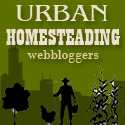 I admit that the cover really drew me in ~ I do love fields of waving golden wheat!
I admit that the cover really drew me in ~ I do love fields of waving golden wheat!The book is well written and easily engages you from the first page. Eric Brende, the author and MIT grad, and his wife, Mary, choose to live in a Minimite community, unplugged from everything. The book gives you a brief backdrop for the decision and then devotes the rest of the pages to the actual living a very rural, off grid experiment. The book covers the farming cycle from planting through harvest.
Minimites are an old Amish order. According to the book jacket, even Amish groups consider them to be so primitive that they are antiquated. Interestingly, the author rents a house without running water, but eventually, the owner convinces them to try to install running water. It's a very elaborate process to get water uphill using a self pumping ram, not electricity. Even Minimists enjoy indoor running water.
What I like the best was that nothing was left out. Every detail was covered (to the point that I'm now seriously considering buying an Amish wringer washer) so that the reader could actually implement the lessons learned and shared. I also liked that the author shared technical information in a straight-forward way.
The book shared quite a bit of self discovery such as when the author was tired and hungry and got into a fight with his wife over being hungry and wanting to eat. Neither one were very adept at cooking and without refridgeration, 3 meals a day had to be made completely from scratch. There was no way to store leftovers (well, they hadn't considered it yet.) What followed was a discovery of a local cookbook and better ways to store food. It reminds me of the phrase, "When the student is ready, the teacher will appear."
As I read the book, I referred often to the hand drawn map included. I found myself wanting to know a lot more, about the people and how they lived and what they thought of modern day "improvements". I would love to be able to purchase some of the Amish made tools that seem to be better made and longer lasting and of course, see the gardens & barns in person. I appreciate how things are built and I'd love to see some of the structures that they built.
I also like reading about the various gardening, livestock and community ideas that are presented. There are Amish and Mennonite communities within an hour of Wichita, but I don't suppose I could just show up and hang out for a day or two, learning from them, so this book was a great insight to a simpler life.
I won't be shutting off our utilities anytime soon, but the book reminded me of the cost involved in having conveniences, and it's obviously not just monetary. This book is a keeper ~ so while I'll return the libraries copy, I'll definitely be getting one for myself.











5 comments:
Sounds like a very interesting book! I just noticed you are in KS, we are too!
I loved that book, in fact I read it twice lol. If you like that one, try The Good Life by Helen and Scott Nearing, or Animal-Vegetable-Mineral by Barbara Kingslover.
We both love going to amish country, and I'm actually going back tomorrow with my 73 year old uncle to take him to some out of the way antique stores. Those are always the best ones, far off the beaten path of tourists and the ones wanting "country crafts". I'll be of course stopping by Lehmans as always. Check them out if you aren't familiar with them. ( www.lehmans.com ), they carry a LOT of books on the insight of amish life if it interests you.
I think I would really enjoy reading that book too. otta put it on my to-read-list. Thanks.
Happy New Year!
I smell the possiblity of very detailed honey do list for my husband. Because we certainly don't have enough new techno-amish tasks to keep us occupied.
Thanks for the book review
Post a Comment